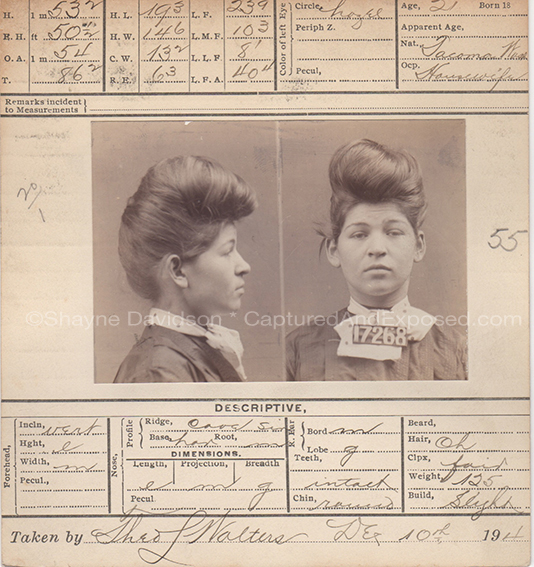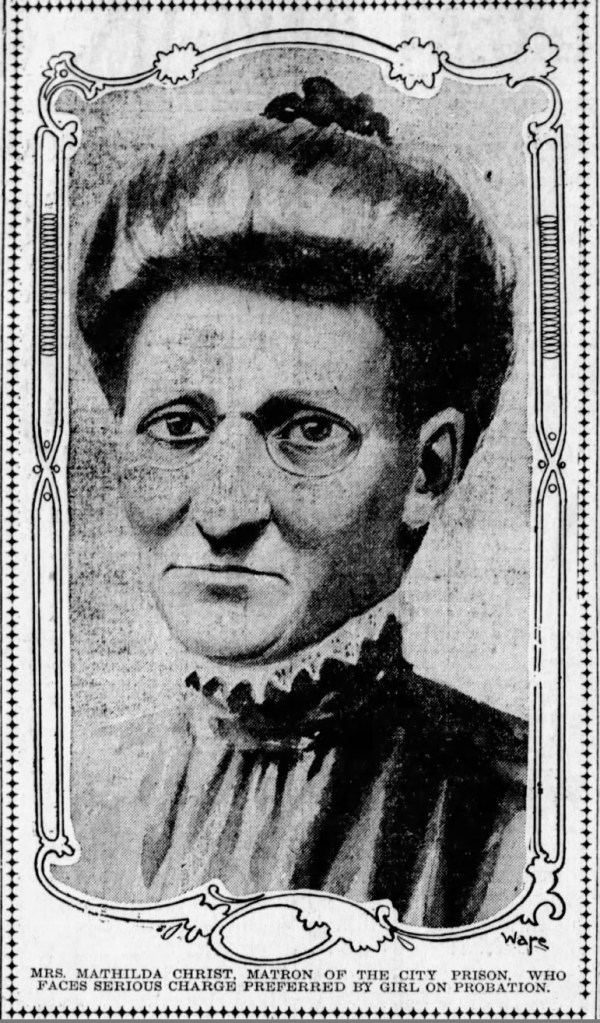Fay Bucke was arrested for stealing clothing and furs valued at the princely sum of $540 (worth about $16,000 today) from her landlady in 1904. Despite the dire circumstances she found herself in, Fay took the time to style her hair—the updo she sported in her mugshot is nothing short of magnificent.
If you’re wondering why the landlady, Rose Decker, had such valuable clothes, the answer is because she was a madam who ran a bordello in the Tenderloin district of San Francisco. Dressing well was a requirement of the job.
Fay testified in court that she’d arrived in San Francisco a few months earlier without money or friends. In order to survive she’d been enticed to work in a “house of ill-repute.” She said she’d stolen the clothes in order to pawn them for cash and escape from a “life of shame.”

Stealing nice clothes was a practice Fay may have learned from Rose. A few months before she absconded with Rose’s clothes, Rose stole a trunk full of the belongings of Nellie Bennett, one of the working girls in her house. Nellie was late on her rent to the tune of $110, so Rose helped herself to Nellie’s clothing. She also stole some photographs given to Nellie by one of her admirers. Nellie agreed to drop the charges and give up the clothes as long as Rose returned the photos.
Fay wasn’t so lucky. Rose pursued the charges and she was convicted of grand larceny. When she appeared before Judge William P. Lawlor for sentencing in February 1905, she begged for probation. In support of her plea she presented a letter written by a man she claimed was her husband: J. Douglass Bucke of Butte, Montana.

Evidently the plan had been for Fay to travel on her own from her home in Washington State via San Francisco to Montana. How she could do that without funds was a question that no one asked. In the letter Bucke insisted that that Fay was a person of good character. He took responsibility for her plight, writing that he should have met her at the dock when she landed in San Francisco. Bucke also wrote that he was “unable to appear in person to plead for one whom I love and who is alone in the world with the exception of myself.”
Fay was convicted of grand larceny. Sentenced only to probation, Judge Lawlor sent her to live with a jail matron, Matilda Christ. But instead of the nanny job she’d been promised, Matilda forced Fay to work as a waitress in a restaurant. According to Fay, Matilda also made her turn over most of her salary to pay for her room. Matilda also forced her to pay back a loan she’d made to Fay so that she could buy clothing.

After a few weeks of long, tiring days at the restaurant Matilda came up with an alternative. She suggested Fay rent a flat where she could “solicit men” for sex and proposed they share the profits. Disgusted by the idea and unwilling to return to that life, Fay ran away from Matilda’s house. She went before Judge Lawlor and told him the story of Matilda’s treacherous plans.
Matilda was “white with rage” when she heard what Fay had told the judge. She strongly denied the story and claimed that Fay had stolen several rings and some clothing from her. She later admitted that she “found” the items in her house and “forgot” to tell the court about it.
Judge Lawlor couldn’t find any hard evidence of the scheme to set Fay up as a prostitute—it was really just the word of one woman against the other. Nonetheless he gave Matilda a “severe censure” for not telling the court she’d been mistaken about the thefts.
Fay admitted during one of many court hearings that she wasn’t actually married to J. Douglass Bucke. Judge Lawlor said he “didn’t believe Fay was of the criminal class” and he released her on probation to the custody of the Mother Superior of St. Catherine’s Home for wayward girls. A few months later she and Bucke were married, but it didn’t last long. She filed for divorce from him on the grounds of desertion in July 1907.
Matilda Christ was forced to resign from her job as prison matron due to the bad publicity over her mistreatment of Fay.
The brothel owner, Rose Decker, continued to have run-ins with the San Francisco Police throughout the first decade of the 20th century. The Hotel Nikko San Francisco now stands on the spot where her bordello was located in 1904.
Featured photo: Fay Bucke in a Bureau of Identification photo taken by the San Francisco Police Department on December 10, 1904. (author’s collection)


What a cast of characters! You can’t make this stuff up . . .
LikeLiked by 1 person
No kidding, Liz! I want a time machine so I can go visit San Francisco in the bad old good old days!
LikeLiked by 1 person
😀
LikeLike
you know what I’m gonna say.
LikeLiked by 1 person
I do!
LikeLike
How much should a judge trust a criminal? Please keep me informed of the next departure of any time machine to our historical past. Until then, I’m reading yesteryear’s newspapers.
LikeLiked by 1 person
I guess it depends on the judge and the criminal!
LikeLike
The theme of this story seems to be one of older women taking advantage of a penniless young woman. Kudos to Judge Lawlor for taking Fay’s side. At the very least, he must have recognized the imbalance of power in those relationships.
LikeLiked by 1 person
I agree. He went on to be a justice on the California Supreme Court. Thanks Brad!
LikeLiked by 1 person
I agree with Brad’s take. Fay doesn’t sound like a bad person. What happened to her after her divorce from Bucke?
LikeLiked by 1 person
I never figured out what her maiden name was, so that made it impossible to trace her. Thanks, Eilene!
LikeLiked by 1 person
Hmm. Not on her marriage record?
LikeLiked by 1 person
I never located a marriage record for the couple. The San Francisco Call newspaper printed a notice of Fay’s divorce suit against her husband in July 1907. I did find a record for a James Douglas Bucke who married Anna Hershey in October 1906 in Golden, CO. Seems likely to me that it’s the same guy and he was a bigamist.
LikeLiked by 1 person
I can’t imagine what it was like in an era when a majority of women weren’t even referred to by their own name. In the newspapers especially, a woman was Mrs. John Doe, never Mary Ruth Adams Doe. Those were good reasons for an identity crisis. No wonder women fought so hard for equal rights and the vote. No wonder woman (and men) are still fighting for equal tights, equal pay, etc.
LikeLiked by 1 person
Great points!
LikeLike
Did I say equal tights?
LikeLiked by 1 person
Everyone should have equal tights!
LikeLiked by 1 person